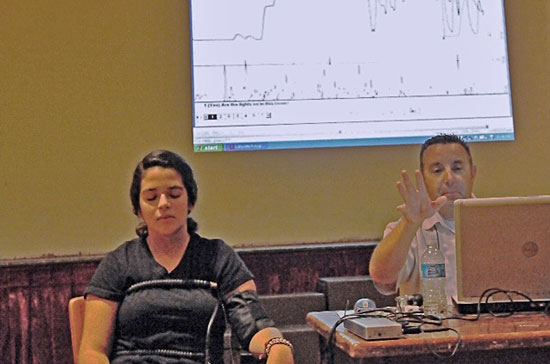October 12, 2012
No Comments
Appointed last October, Probation Chief Jerry Powers promptly became responsible for realignment’s rollout.
Don’t expect a lot of folks in Los Angeles government to be toasting Sacramento in celebration of this month’s one-year anniversary of the most dramatic remake ever of California’s criminal justice system. Called “realignment,” it triggered a massive overnight transfer from the state to its counties of responsibility for supervising certain ex-prisoners and jailing a new, more serious class of offender.
The changes were pushed by the governor and legislature despite strong resistance from local authorities, who argued that the plan was being rushed to relieve the state of its prison crowding and budget problems at the expense of public safety and the dwindling resources of local governments.
Now, data collected by Los Angeles County suggests that the impact here is even more challenging than anyone envisioned, prompting a scramble for new solutions and dollars.
County officials say, for example, that they received more “high risk” former state inmates to supervise than they’d initially predicted, and many arrived with mental illnesses that were far more serious than expected. Those individuals have been placed in costly lock-down psychiatric facilities, leap-frogging other patients who’ve been bumped to waiting lists and, as a result, are consuming precious beds in public hospitals.
Meanwhile, more than 30% of the 11,000 former state inmates whose supervision has been transferred to the county’s Probation Department were rearrested during the past year for allegedly committing crimes ranging from vehicle code violations to serious felonies, including 16 murders, 23 attempted murders and 205 robberies. County officials emphasize, however, that these same alleged offenses could just as easily have occurred had state parole officers remained responsible for post-release supervision.
And it doesn’t end there. County probation Chief Jerry Powers says another provision of the realignment law, AB 109, carries the potential of even more problems, placing new strains on the county’s already bursting jail system and raising more questions about risks to the public.
Under AB 109, the county is now responsible for jailing criminals convicted of non-serious, non-violent, non-sexual crimes—offenders, who, in the past, would have been sentenced to state prison and placed on parole after their release. But under the realignment law, there’s no requirement—or funding source—for them to have any supervision, or “tail,” at all after their release from county jail.
“Frankly,” Powers told the Board of Supervisors this week, “that scares me more than this population that is coming from the state prison system [for county supervision.]”
The news, however, is not all grim.
With a new class of inmate in the jail, the stakes for public safety have risen.
Reaver Bingham, the point man for realignment in the county’s Probation Department, says his agency has, among other things, begun to beef up supervision ratios because of the unexpected number of ex-state inmates who are considered to be higher risks to commit new crimes. “If they mess up,” he says, “we’re right there to address the violation.”
He also said that 90% of the former state prisoners who’ve been ordered since last October to report to the county had done so, allowing authorities to create customized supervision and treatment plans for them. Of those who failed to show, Bingham says, warrants were issued and most of the missing individuals were contacted or picked up within 30 days. As of this week, he says, there are 917 active warrants, not counting the 529 warrants issued for individuals who’ve now been deported. Bingham acknowledged that some of the county’s new charges have been arrested for new crimes—some of them serious—but he says most are property- and drug-related offenses. More than 600 cases, for example, were for methamphetamine possession, while nearly 400 involved arrests for burglary, according to Sheriff’s Department records.
Bingham says the recidivism among the group is not surprising. Although these ex-inmates were transferred from the state after completing sentences for non-violent, non-serious, non-sexual offenses, they often have earlier, more egregious convictions. “I think it’s safe to say that over 50% have serious and violent crimes in their past,” says Bingham, a 30-year veteran of the probation department.
Like his boss, Powers, Bingham says he’s also concerned about the lack of post-release supervision for inmates who, for the first time, will be serving sentences in county jail rather than in state institutions. So far, the average jail stay for these individuals is 12 months, excluding time already spent in custody and automatic reductions in sentences.
“When they’re out, they’re done,” Bingham says. In the past, when this same class of inmate was released from state prison, they’d receive years of parole supervision, giving California authorities leverage to try to avert bad behavior and reduce recidivism. “Without supervision, we have no opportunity to determine whether these people have benefited from programs they’ve received during incarceration with us,” Bingham says. “We have no idea whether the rehabilitation took to them.”
Law enforcement authorities throughout California have been pushing for legislation that, at a minimum, would attach a “search and seizure” requirement to the release of inmates from county facilities, just as the state has been doing for the same class of prisoner. This would give authorities the right to search a person and his property. Any violations could lead to the filing of new charges.
“At least that way, the system is still in their life,” says Mark Delgado, executive director of the Countywide Criminal Justice Coordinating Committee, which has played a key role in the realignment process here.
From the start, one of the most difficult populations to address in realignment has been those inmates with mental health needs. Initially—until the intervention of the governor’s office—county officials couldn’t even get complete medical histories of these individuals from the state to create treatment programs.
Dr. Marvin Southard, director of the county’s Department of Mental Health, says some of these ex-inmates have “garden variety mental illnesses,” for which about half are engaged in treatment. “The challenge has been that there’s a second minority group with very severe mental illnesses.”
These people, Southard says, have been immediately placed in secure, privately-owned psychiatric facilities with which the county has contracts. “Any one of those cases could have been problematic for individual and public safety,” Southard says.
But, according to Southard, there’s been a price to pay—both in dollars and in the operation of the mental health system. These AB 109 clients, he says, “have jumped the line,” creating a backlog among patients in serious need of those same beds. “This has put more pressure on the psych wards at the county hospitals. It backs up the system.”
Still, Southard, Delgado, Bingham and others say there has been a bright spot in all of this: realignment has forced an unprecedented level of cooperation among agencies throughout the county.
Just last week, for example, the Department of Mental Health, the Sheriff’s Department and the Department of Public Health teamed up to begin providing the new AB109 inmates in county jail with a promising anti-addiction drug called Vivitrol.
“We’re working together more synergistically now than we ever have,” says Bingham, who credits his staff with helping make interagency strides.
“Whether you agree with realignment or not,” adds Delgado, “everyone has pulled together, committed resources and been fully invested in doing whatever they can to make this thing work.”
Posted 10/12/12










